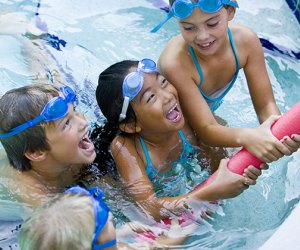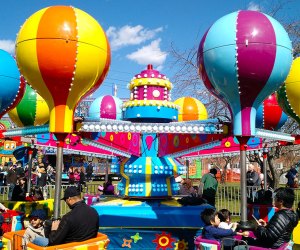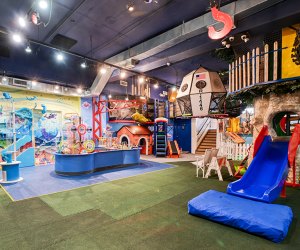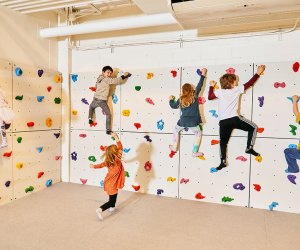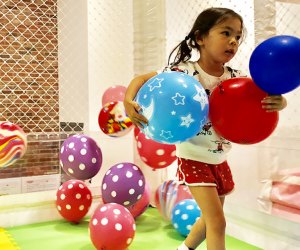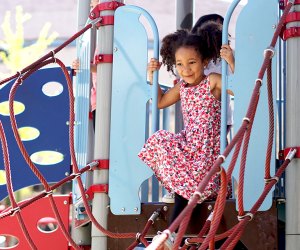What Is Pickleball? Pickleball Rules and Why Kids Love It
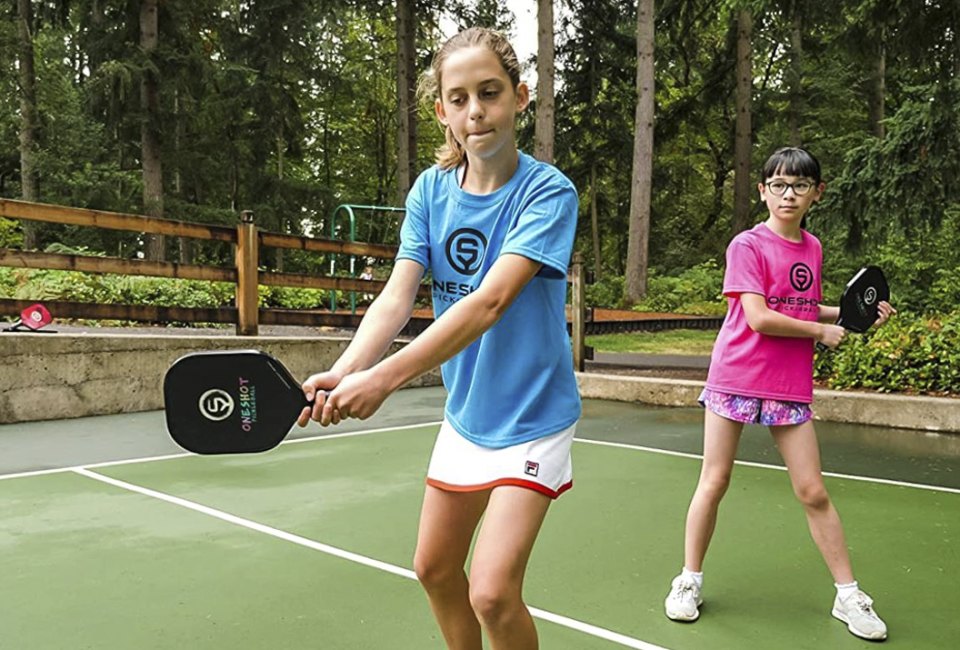
Perhaps your kids came home from school one day and announced, "I played pickleball in P.E. today!" Maybe you've seen ads for pickleball clubs in your community. Or you may have simply driven past the park and noticed an unfamiliar game happening on the tennis court. However you were exposed to it, at some point you've likely wondered, what is pickleball?
Pickleball is a craze that's quickly sweeping the nation because it's fun, affordable, and a great way to get some exercise. And because it's easy to learn and play, families and kids can play together and make memories.
Read on to learn all about pickleball and why it's the perfect family sport. For more outdoor fun with your family, check out our guide to top outdoor activities with kids.
OUR LATEST VIDEOS
What is Pickleball?
Pickleball is an invigorating racquet sport that includes a combination of techniques and game strategies taken from tennis, ping-pong, and badminton. Played on a slightly smaller court than a traditional tennis court, pickleball can be played as either a doubles sport with four players or a singles sport with two players.
Each player holds a racquet similar to a ping-pong paddle, and the balls are plastic with holes in them (similar to a wiffle ball).
History of Pickleball
The origin of pickleball comes from the state of Washington. In 1965, congressman Joel Pritchard and a friend began playing a game similar to badminton, but with ping-pong paddles and plastic wiffle balls. They did this purely for fun and sport, and as they continued to play, they developed rules and criteria for the game. Two years later, the first "official" court was put in Pritchard's backyard, and in 1972 it was officially named the sport of pickleball.
RELATED: 20 Jump Rope Workout Games and Songs for Kids

A pickleball court is slightly smaller than a tennis court. Photo by SLV Marketing, Pixabay
Pickleball Rules
The rules of pickleball are super easy to learn and implement. Here's what to know:
1. The Serve
The pickleball serve is an underhanded or "drop serve" that goes diagonally across the net to the opposite side. Only the team that is serving can score points. Depending on the accuracy of serves, partners and opposing teams take turns serving (see detailed pickleball rules).

After a serve, the ball must bounce once after crossing the net. Photo by Frankie Lopez, Unsplash
2. Scoring Points
After the ball is served, it is required to bounce once after crossing the net and then bounce once on the return from the receiving team. After that, players may volley the ball (hit it without letting it bounce first) or hit it after one bounce. If a ball is out or a violation occurs, it's called a "fault." If the serving team has a fault, they lose a serve; if the receiving team has a fault, the serving team gains a point.
3. The "Kitchen"
The "kitchen" is the area closest to the net on both sides of it. This area is a non-volley zone, meaning that players may not volley the ball there. This is a crucial difference from tennis and prevents players from smacking the ball downwards across the net when close to the opponent's side. There are also specific guidelines for when you can and cannot step in the non-volley area.
4. How to Win
Pickleball is typically played to 11 points, and teams must win by two points. There are some cases where games are played until 15 or 21 points.
RELATED: 35 Classic Backyard Games for Kids to Play Outside This Summer

Pickleball paddles can be simple or splashy. Photo by Joan Azeka, Unsplash
Choosing Pickleball Paddles
Depending on skill level, there are many options for paddles. The original 1960s paddles were made out of wood. Now, you'll find most paddles are made out of aluminum, polymer, and Nomex, though you can still find inexpensive wooden paddles. Overall, you'll want to think about the weight of the paddle, the grip, and the cost.
As far as weight goes, there are pluses and minuses to both lightweight and heavier paddles. Lightweight pickleball paddles tend to be easier to control and more gentle on your arms and elbows. Heavy paddles allow for a stronger force when hitting the ball, but can also be more taxing on the upper body for longer periods of game time.
To choose a proper grip, experts recommend measuring the grip in relation to one's height. A shorter player will use a smaller grip; a taller person will benefit from a larger grip.
Why Pickleball Is a Great Game for Kids and Families
1. It's a Bonding Experience
Pickleball encourages communication, teamwork, and celebration, making it a great family activity that creates lasting memories.

The ball is similar to a wiffle ball. Photo by Ben Hershey, Unsplash
2. It's Inexpensive
Pickleball paddles for beginners generally cost $10-20 and balls cost about $10. If you get more serious about the sport, you can of course upgrade to pricier options. But unlike some other racquet sports, you don't need to spend a lot of money to enjoy pickleball.
3. It's Great Exercise
According to NHS Inform, pickleball and other racquet sports are an aerobic activity that can lower resting blood pressure and help balance body weight. Playing can also strengthen the upper body and improve coordination.
4. It Has Simple Rules
As we detailed above, the pickleball rules are very easy to understand, especially for families and kids that are already familiar with tennis.
RELATED: 12 Hiking Games for Kids That Turn Walks into Adventures Again

Kids can socialize while learning good sportsmanship. Photo courtesy of Total Pickleball, Facebook
5. It's Good for Socialization
Whether it's an after-school activity, a birthday party, or a weekend playdate, pickleball can be a confidence-builder for kids and a way to make new friends.
6. You Can Play Anywhere
The exact pickleball-court dimensions are 20 feet by 44 feet. But if you can't find or build a court that's precisely that size, just grab a piece of chalk and make the marks on a tennis court to create your own play space. If you don't have access to a net or a tennis court, get creative—find a flat surface, tie some string between two trees for a net, and you've got a makeshift court.
7. You Can Spend Time Outdoors
A great aspect of pickleball is that it can be played both indoors and outdoors. So if you're trying to get your kids off screens and outside, head to a local park and set up on the tennis courts to soak in the fresh air while playing a new sport.
8. It's Another Organized-Sport Option
Since the pickleball craze is currently a big hype in schools, lots of team tournaments are popping up. That means kids who don't play more traditional organized sports like football and baseball have another chance to be part of a team. If your child's school doesn't have a pickleball program, see if you can gather other parents to express interest in adding one. You can also search for or start a junior pickleball program in your area.
9. It's a Skill-Builder
In addition to the social end emotional benefits of pickleball, the sport can also help kids develop hand-eye coordination and motor skills.
RELATED: 50 Fun Activities for Grandparents To Do with Kids
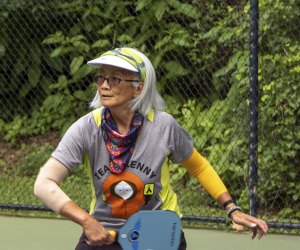
Grandparents and grandkids can even play together! Photo by Steven Rahn, CC BY-SA 2.0
10. It's a Game for All Ages
There is truly no age limit for pickleball, meaning grandparents and youngsters alike can play together. That makes it the perfect activity for family vacations and reunions or for holiday gatherings. Just don't get mad if Grandma is crowned the pickleball champ!







